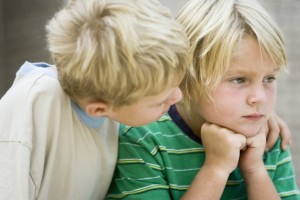
When Harvard University’s Making Caring Common Project released their report, “The Children We Mean to Raise: The Real Messages Adults Are Sending About Values,” many parents and educators — myself included — were surprised to learn that despite all our talk about instilling character and empathy, kids may value academic achievement and individual happiness over caring for others. In the report, the authors explained that the children’s values reflected what they believe adults value.
In the wake of these dispiriting study results, the Making Caring Common Project and the Ashoka Empathy Initiative created a set of recommendations for teaching empathy to children.
Empathy goes beyond being able to see another person’s point of view, Rick Weissbourd, the co-director of the Making Caring Common Project, explained in an email. He points out that sales people, politicians, actors and marketers are able to do this kind of “perspective-taking” in pursuit of their professional goals. Con men and torturers use this ability to manipulate their victims for personal gain. In order to be truly empathetic, children need to learn more than simple perspective-taking; they need to know how to value, respect and understand another person’s views, even when they don’t agree with them. Empathy, Mr. Weissbourd argues, is a function of both compassion and of seeing from another person’s perspective, and is the key to preventing bullying and other forms of cruelty.
To that end, the project offers these five suggestions for developing empathy in children:
1. Empathize with your child and model how to feel compassion for others.
Kids develop these qualities by watching us and experiencing our empathy for them. When we show that we truly know our children by understanding and reacting to their emotional needs, exhibiting interest and involvement in their lives, and respecting their personalities, they feel valued. Children who feel valued are more likely to value others and demonstrate respect for their needs. When we treat other people like they matter, our kids notice, and are more likely to emulate our acts of caring and compassion.
2. Make caring for others a priority and set high ethical expectations.
Kids need to know that we are not simply paying lip service to empathy, that we show caring and compassion in our everyday lives. Rather than say, “The most important thing is that you are happy,” try: “The most important thing is that you’re kind and that you are happy.” Prioritize caring when you talk about others, and help your child understand that the world does not revolve around them or their needs.
3. Provide opportunities for children to practice.
Empathy, like other emotional skills, requires repitition to become second nature. Hold family meetings and involve kids by challenging them to listen to and respect others’ perspectives. Ask children about conflicts at school and help them reflect on their classmates’ experiences. If another child is unpopular or having social problems, talk about how that child may be feeling about the situation, and ask your child how he or she may be able help.
4. Expand your child’s circle of concern.
It’s not hard for kids to empathize with their immediate family and close friends, but it can be a real challenge to understand and feel for people outside of that circle. You can help your child expand their circle by “zooming in and zooming out”; listening carefully to a particular person and then pulling back to take in multiple perspectives. Encourage your child to talk about and speculate on the feelings of people who are particularly vulnerable or in need. Talk about how those people could be helped and comforted.
5. Help children develop self-control and manage feelings effectively.
Even when kids feel empathy for others, societal pressures and prejudices can block their ability to express their concern. When kids are angry with each other over a perceived slight, for example, it can be a real challenge for them to engage their sense of empathy. Encourage kids to name those stereotypes and prejudices, and to talk about their anger, envy, shame and other negative emotions. Model conflict resolution and anger management in your own actions, and let your kids see you work through challenging feelings in your own life.
Educators will tell you that a classroom full of empathetic kids simply runs more smoothly than one filled with even the happiest group of self-serving children. Similarly, family life is more harmonious when siblings are able feel for each other and put the needs of others ahead of individual happiness. If a classroom or a family full of caring children makes for a more peaceful and cooperative learning environment, just imagine what we could accomplish in a world populated by such children.